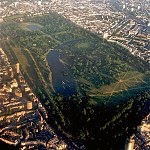Russia Dock Woodland

Russia Dock Woodland is a long narrow park in Rotherhithe, London, created by the infilling of one of the former Surrey Commercial Docks. The former Russia Dock was originally used for the importing of softwood timber from Norway, Russia and Sweden. Known as "deal wood", it was mostly used for newsprint and for manufacturing furniture.
Following the closure of the docks in the early 1970s, the area was redeveloped by the London Docklands Development Corporation (LDDC). Russia Dock Woodland was made up of a number of docks, including Russia Dock, Island Dock and Surrey Basin, which were infilled (save for a thin 'stream' through the woodland) and planted as a 34.5-acre (140,000 m2) woodland in 1980. The Woodland still contains surviving dock features including the retaining wall capstones, depth gauges, bollards, mooring chains and tracks.
Management[]
The woodlands were established by the LDDC and were handed over to and are now managed by Southwark Council with the assistance of the Friends of Russia Dock Woodland. The LDDC established various footbridges (including the Alfred Salter footbridge) and paths (including Waterman's path along the stream) through the woods, which are now maintained by Southwark Council.[1] The Conservation Volunteers (formerly the Trust for Urban Ecology) maintain the neighbouring Stave Hill Ecological Park,[2] and works closely with the Friends of Russia Dock Woodland to address issues of concern to both areas.[1] Both areas are an excellent resource for residents of and visitors to Rotherhithe.
Stave Hill[]

Stave Hill itself is a 30-foot (9.1 m) high artificial mound in the shape of a truncated cone, with a viewing platform and relief map of the former docks in cast bronze by Michael Rizzello at the top. It provides views over Canary Wharf, the City of London, and much of south and central London; on clear days the view stretches as far as Wembley Stadium.[citation needed]
It was created in 1985 by the LDDC, using waste material and rubble from the works to fill and landscape the former commercial docks.
References[]
External links[]
- Russia Dock Woodland
- Stave Hill Information at the Trust for Urban Ecology
- Russia Dock Woodland, Stave Hill and Greenland Dock
- Russia Dock Woodland on the VisitWoods website
Coordinates: 51°30′04″N 0°02′20″W / 51.501°N 0.039°W
This article needs additional citations for verification. (February 2010) |
- Forests and woodlands of London
- Parks and open spaces in the London Borough of Southwark
- London docks
- Redeveloped ports and waterfronts in London
- Rotherhithe


